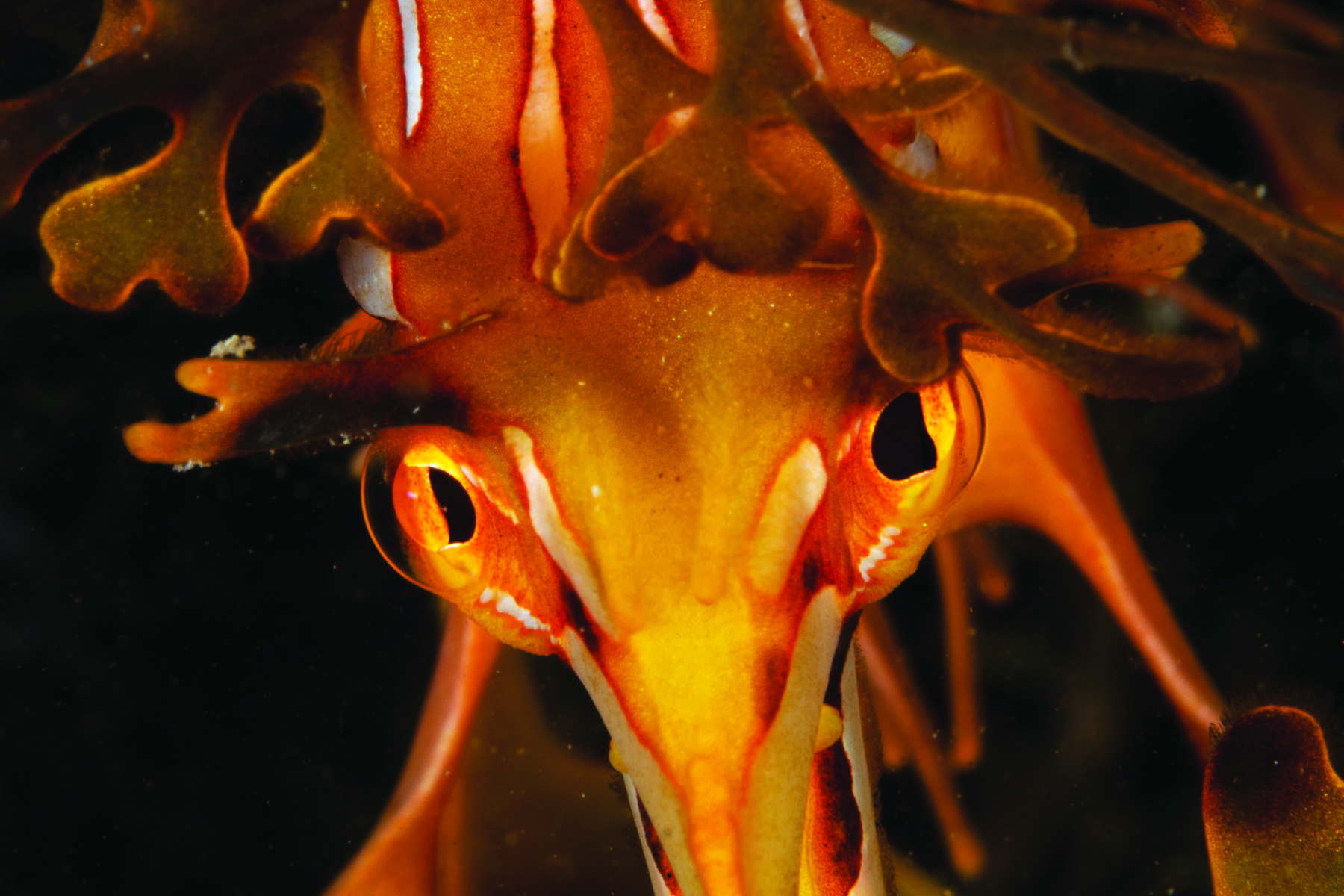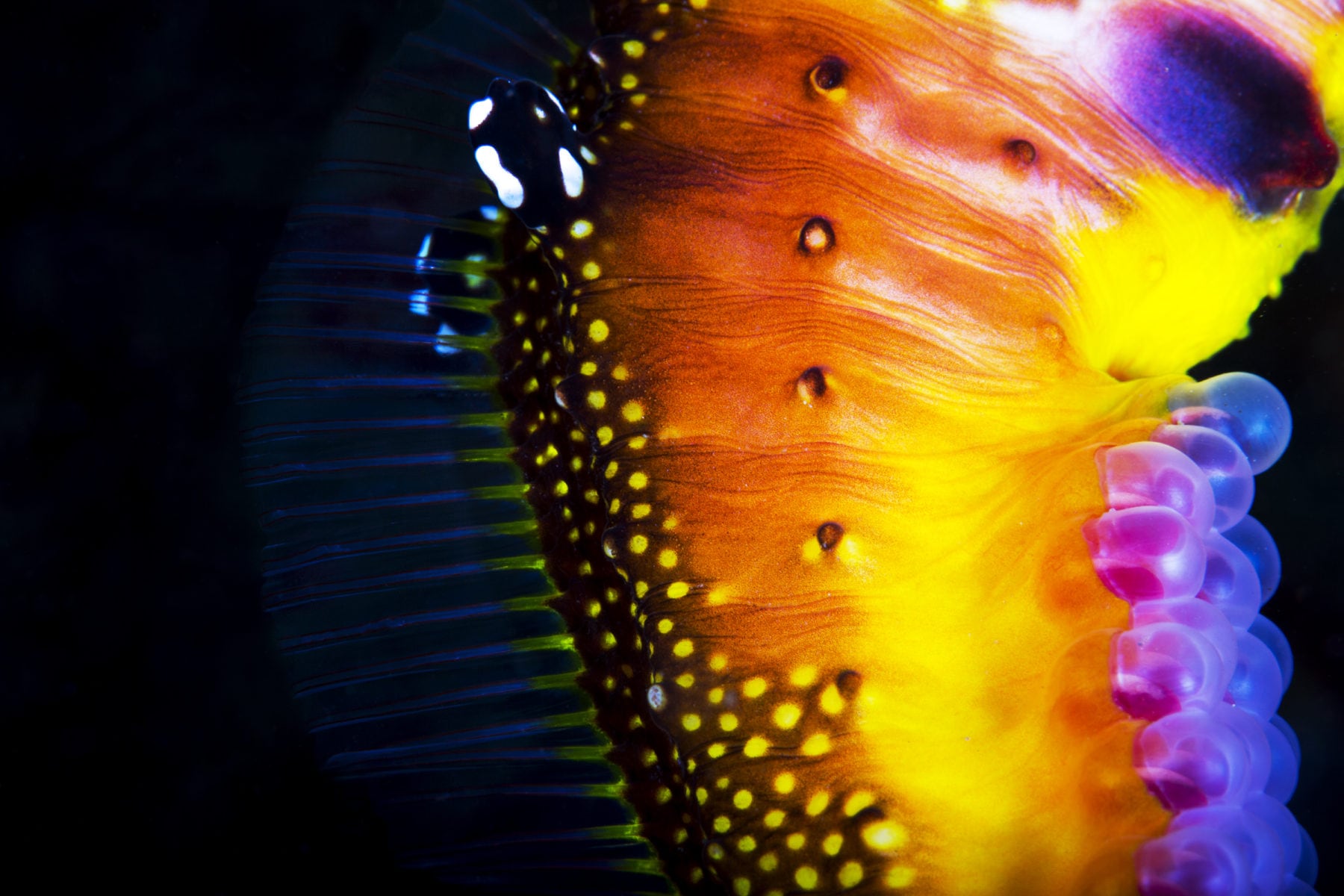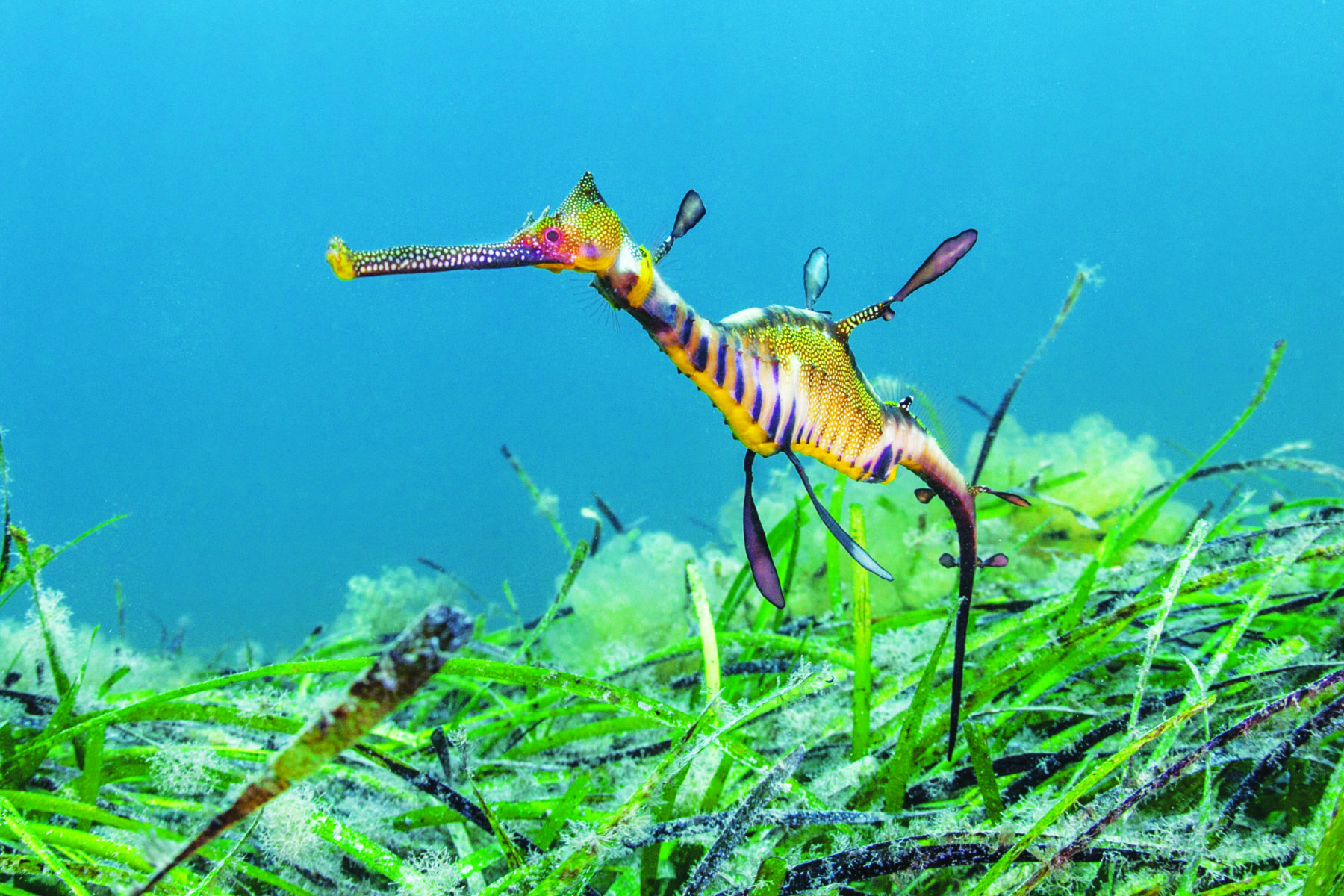BECAUSE I GREW UP IN SYDNEY, the ocean was always an intrinsic part of my life. But it wasn’t until I learnt to scuba dive in my late teens that I really began to appreciate how Australia’s ocean waters are home to so many creatures found nowhere else in the world.
Among the most spectacular are the seadragons, a group of remarkable fish that have fascinated me since I first heard of them about 25 years ago. Now I’m committed to learning as much as I can about these intriguing animals and I’m using my images to help protect them.
Everything you need to know about seadragons
Seadragons belong to the family Syngnathidae. There are just three species of seadragon and they only occur in the temperate waters of the Great Southern Reef (GSR), which spans Australia’s southern coasts, covering some 71,000sq.km along roughly half of the continent’s land mass from New South Wales to Western Australia. A biodiversity hotspot largely dependent on kelp forests and other large seaweeds, the GSR supports diverse endemic species in nutrient-rich waters.
The three seadragon species are visually distinct. The weedy (Phyllopteryx taeniolatus) and leafy (Phycodurus eques) seadragons are better known than the third, the ruby seadragon (Phyllopteryx dewysea), which was only recently discovered and can be identified by its bright red colour.
The weedy, also known as the common, is easily distinguished from the leafy by its small, less-ornate fins – a long dorsal one low on its back and a pectoral fin located up on its neck – that oscillate rapidly to provide propulsion through the water. Situated close to its tail, the dorsal fin provides forward movement. The pectoral fin allows the fish to steer and change direction.

All seadragons feed on small, shrimp-like crustaceans, their favourites being the mysids, or sea lice, which swim in swarms. Because they lack a true stomach, seadragons have no capacity for food storage and so need to eat continuously.
Their eyes move independently of each other, allowing them to focus on objects located just beyond their pipe-like snouts. This means they can target tiny crustaceans in close proximity. Mysids are fast-moving, so the nearer a seadragon can get, the better its chance of catching one.
Adult leafy seadragons have an average length of 35cm, while the weedy grows up to about 45cm. It’s not known how long these fish live in the wild but in captivity they have survived for as long as nine years, almost twice as long as seahorses.
Weedy seadragons breed during the warmer months, from October to late February. But they have more than one breeding period because they’ve been seen with eggs at other times of the year.
Leafy seadragons begin pairing up in September and a first brood of eggs is seen by October or November. A second brood is common and can occur in late December or January.
A brood takes up to eight weeks to hatch, and, as for seahorses, incubation is the sole responsibility of the male: the eggs are fertilised as they’re transferred from the female to the male.
Each brood consists of about 250 eggs, which the male carries along a spongy patch on the underside of his tail. Until it’s ready to hatch, each egg is housed in an individual cup-like indentation in this pulpy area, which has increased blood flow to enrich the eggs during incubation.
The eggs are brightly coloured and vary in weedy seadragons from pink to dark purple – they’re pinkish-orange in the leafy. Their hatching is staggered and assisted by the male who shakes his tail or rubs it over seaweed and seagrass to encourage the hatchlings, each just 4–7mm, to emerge.
The tiny seadragons are then independent and on their own, relying on camouflage for protection until fully grown. Newly hatched seadragons live at first off the last of their yolk sacs, which
initially remain attached to them. Then they hunt tiny zooplankton until their snouts become large enough to take juvenile mysids.
Adult seadragons have few known predators. Most are successfully duped by the seadragons’ sophisticated camouflage, and any would-be predators are usually deterred by the tough bony plates under a seadragon’s skin.
Weedy and leafy seadragons inhabit shallow water, 5–25m deep, where their habitat varies from seagrass meadows to underwater forests of kelp and other seaweed. They often occur in vegetation near long jetties teeming with other marine life.
As well as having those leaf-like appendages that enable them to blend in among seaweed and seagrasses, they can also gradually change colour to match their surroundings. To complete their clever subterfuge, they mimic the swaying movements of the marine vegetation around them.

DragonSearch
In 1996 a coalition of researchers and community organisations established DragonSearch to collect data on wild seadragon populations across Australia. The work and long-term commitment of the program’s South Australia project manager, Tony Flaherty, several project officers, and marine scientist Janine Baker, together with the efforts of the diving community across the country, has led to better understanding of where seadragons occur and more accurate estimates of their population numbers. It has also revealed key insights into the biology (such as breeding times), habitat and behaviour of these remarkable fish.
During the late 1990s, before seadragons and their relatives became formally protected under SA government legislation in 2006, a code of conduct for diving with the fish was developed in conjunction with community groups. This was recently updated to recognise the increasing numbers of interactions between the fragile creatures and divers.
A seven-year monitoring program by DragonSearch divers and SA project managers identified and tracked individual seadragons at one of the popular diving locations in SA, but other research is ongoing.
Using the online citizen science platform iNaturalist, curated by the California Academy of Sciences and the National Geographic Society, contributors are now also being encouraged to submit seadragon photos.
Researchers are using these to collect data about seadragons’ geographic locations, frequency and relative population sizes.
“The aim of the long-term research is to identify site-association of seadragons, including the identification and monitoring of individuals, and to highlight sites suitable for increased protection and management of potential impacts,” Janine explains.
“Our long-term work in SA aims to also create a sense of engagement and ownership in the community.”
Recognising seadragon individuals is not easy. Researchers closely examine the animals’ faces, snouts, heads and bodies to identify them. Variations in facial and body patterns, unique markings and distinctive features such as missing tails or appendages also help.
Seadragon identification work has been underway in SA since 1999, and the results have been enormously beneficial in increasing knowledge about seadragon biology and those population dynamics.
Advances in image-matching technologies are now also being used for seadragon identification, including a new program called SeadragonSearch, which uses software from Wild Me, a US-based not-for-profit company that supports citizen science.
Its Wildbook software allows seadragon researchers to automate the matching process by using artificial intelligence to increase the speed and accuracy with which they can analyse images submitted by divers. This allows for more effective monitoring of seadragon populations.

Better understanding seadragons
The leafy seadragon is SA’s state marine emblem and a must-see for anyone diving in the state. It has also become a powerful symbol for the need for conservation of SA coastal habitats and for Australia’s ocean environments in general.
The flipside of this high exposure is that poaching has become a major issue in some areas, despite the seadragons’ protected status. As with many other marine species, seadragons are also facing the triple threat of climate change, pollution and habitat destruction, the latter being a particular problem. Their success as a species has relied heavily on the availability of specialised habitats that enable them to blend in, such as forests of kelp and other seaweeds, and seagrass beds.
But these are now under pressure from coastal development and climate change, and the consequences for seadragons are potentially catastrophic.
Marine ecologist John Turnbull is a research officer with the Underwater Research Group of NSW, a scuba diving club and community organisation dedicated to furthering underwater exploration and sharing information about Australia’s marine ecosystems through citizen science.
A key project is weedy seadragon monitoring run in collaboration with researchers from the University of Technology Sydney (UTS) and Sydney Institute of Marine Science. The project relies on images taken by citizen scientists at dive sites in NSW, Victoria, SA and Tasmania.
John and his team encourage divers and underwater photographers to return to the same sites regularly and photograph the same individuals over several years. They also educate divers on how to shoot photos in ways that are most useful for comparing data. Each new seadragon photograph is analysed and added to an image database.
“This information becomes invaluable and allows scientists to extend the reach of their research,” John says.
For Dr David Booth, a UTS marine ecology professor, the weedy seadragon program is critical in helping researchers better understand the species, its behaviours, and habitats.
He says that building this knowledge will help ensure the conservation of these marine animals: “Research is looking at genetics and environmental effects around southern Australia, but the fragility of the species and their retreating habitat is what concerns many scientists.”
With a suspected decline in population sizes, David says it’s vital to gather as much information as possible now.
Despite these indications of a potential reduction in seadragon numbers, the IUCN Red List of Threatened Species changed the status of weedy seadragons from near threatened to least concern in their most recent assessment.
David believes the IUCN assessment needs urgent updating. And that, he adds, makes the current suite of citizen science projects vital.
“This research and the distribution of accurate information is important to convince governments and local councils to support efforts to ensure the survival of the species and look at habitat protection plans.”






